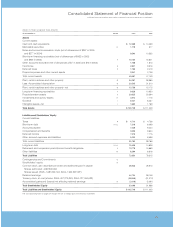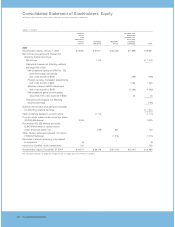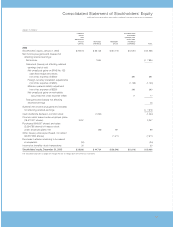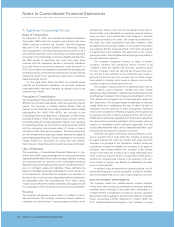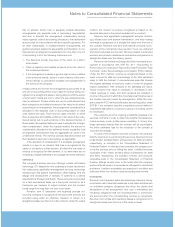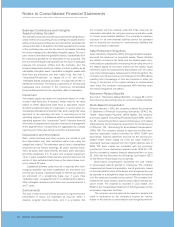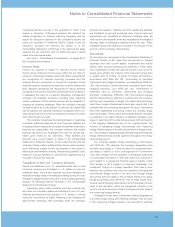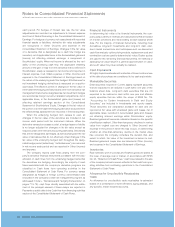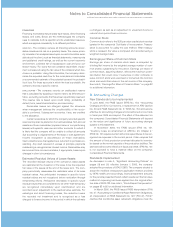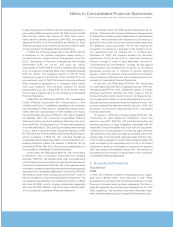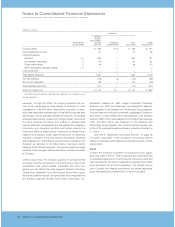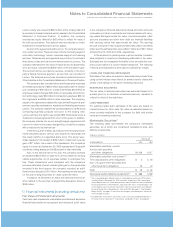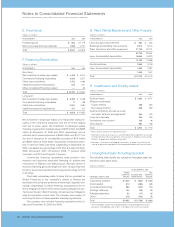IBM 2005 Annual Report Download - page 59
Download and view the complete annual report
Please find page 59 of the 2005 IBM annual report below. You can navigate through the pages in the report by either clicking on the pages listed below, or by using the keyword search tool below to find specific information within the annual report.
NotestoConsolidatedFinancialStatements
INTERNATIONALBUSINESSMACHINESCORPORATION ANDSUBSIDIARYCOMPANIES
58_ NotestoConsolidatedFinancialStatements
BusinessCombinationsandIntangible
AssetsIncludingGoodwill
Thecompanyaccountsforbusinesscombinationsusingthepur-
chasemethodofaccountingandaccordingly,theassetsandlia-
bilitiesoftheacquiredentitiesarerecordedattheirestimatedfair
valuesatthedateofacquisition.Goodwillrepresentstheexcess
ofthepurchasepriceoverthefairvalueofnetassets, including
theamountassignedtoidentifiableintangibleassets.Thecom-
panydoesnotamortizethegoodwillbalance.Substantiallyallof
thecompany’sgoodwillisnotdeductiblefor taxpurposes.The
primarydriversthatgenerategoodwillarethevalueofsynergies
between the acquired entities and the company and the
acquiredassembledworkforce,neitherofwhichqualifiesasan
identifiable intangible asset. Identifiable intangible assets with
finite lives are amortized over their useful lives. See note C,
“Acquisition/Divestitures” on pages 63 to 67 and note I,
“IntangibleAssetsIncludingGoodwill,” onpages 68 and 69,for
additionalinformation. Theresultsofoperationsoftheacquired
businesses were included in the company’s Consolidated
FinancialStatementsfromtherespectivedatesofacquisition.
Impairment
Amortizable assets are tested for impairmentbased on undis-
countedcash flowsand,ifimpaired,written downtofair value
based on either discounted cash flows or appraised values.
Goodwillis testedannuallyforimpairment,orsoonerwhencir-
cumstancesindicateanimpairment mayexist,usingafairvalue
approach at the reporting unit level. A reporting unit is the
operatingsegment,orabusiness, whichisonelevelbelowthat
operatingsegment(the“component” level)ifdiscretefinancial
informationispreparedandregularlyreviewedbymanagement
atthe segment level. Componentsareaggregatedasasingle
reportingunitiftheyhavesimilareconomiccharacteristics.
DepreciationandAmortization
Plant, rental machines and other property are carried at cost
and depreciated over their estimated useful lives using the
straight-linemethod.Theestimatedusefullivesof depreciable
properties are as follows: buildings, 50 years; building equip-
ment,20years;landimprovements,20years;plant,laboratory
andofficeequipment,2to15years;andcomputerequipment,
1.5to5years.Leaseholdimprovementsareamortizedoverthe
shorteroftheirestimatedusefullivesortherelatedleaseterm,
nottoexceed25 years.
Capitalizedsoftwarecostsincurredoracquiredaftertech-
nological feasibility has been established are amortized over
periodsupto 3 years.Capitalizedcostsforinternal-usesoftware
are amortized on a straight-line basis over 2 years. (See
“SoftwareCosts” onpages 56and57 foradditionalinformation).
Otherintangibleassetsareamortized over periods between 3
and 7years.
Environmental
Thecostofinternalenvironmentalprotectionprogramsthatare
preventative in nature are expensed as incurred. When a
cleanup program becomes likely, and it is probable that
thecompany will incurcleanup costs andthose costs canbe
reasonablyestimated,thecompanyaccruesremediationcosts
for known environmental liabilities. The company’s maximum
exposure for all environmental liabilities cannot be estimated
and no amounts are recorded for environmental liabilities that
arenotprobableorestimable.
AssetRetirementObligations
Assetretirementobligations(ARO) arelegalobligationsassoci-
ated with the retirement of long-lived assets. These liabilities
areinitially recordedatfairvalueand the relatedasset retire-
mentcostsarecapitalizedbyincreasingthecarryingamountof
the related assets by the same amount as the liability. Asset
retirementcostsaresubsequentlydepreciatedovertheuseful
livesoftherelatedassets. Subsequenttoinitial recognition,the
companyrecordsperiod-to-periodchangesintheAROliability
resulting from the passage of time and revisions to either the
timingor the amount of the original estimate of undiscounted
cash flows. The company derecognizes ARO liabilities when
therelatedobligationsaresettled.
Retirement-RelatedBenefits
Seenote V,“Retirement-RelatedBenefits,” onpages 85 to95 for
thecompany’saccountingpolicyforretirement-relatedbenefits.
Stock-BasedCompensation
EffectiveJanuary1,2005,thecompanyadoptedtheprovisions
of Statement of Financial Accounting Standards (“SFAS”) No.
123(R), “Share-Based Payment” (SFAS 123(R)). The company
previouslyappliedAccountingPrinciplesBoard(APB)Opinion
No.25,“AccountingforStockIssuedtoEmployees,” andrelated
Interpretationsandprovidedtherequiredproformadisclosures
ofSFASNo.123,“AccountingforStock-BasedCompensation”
(SFAS123).Thecompanyelectedto adoptthemodifiedretro-
spective application method provided by SFAS 123(R) and
accordingly, financial statement amounts for the periods pre-
sented herein reflect results as if the fair value method of
expensinghadbeenappliedfromtheoriginaleffectivedateof
SFAS 123. Such results are consistent with the previously
reported pro forma disclosures required under SFAS No. 123.
Seethecompany’s restated financial statements filed onJune
22,2005withtheSecuritiesandExchangeCommission(SEC)
fortheeffectofthischangeonpriorperiods.
Stock-based compensation represents the cost related
to stock-based awards granted to employees. The company
measuresstock-basedcompensationcostatgrantdate,based
ontheestimatedfairvalueoftheaward,andrecognizesthecost
asexpenseonastraight-linebasis(netofestimatedforfeitures)
overtheemployeerequisiteserviceperiod. Thecompanyesti-
matesthefairvalueofstockoptionsusingaBlack-Scholesval-
uation model. The expense is recorded in Cost, SG&A, and
RD&EintheConsolidatedStatementofEarningsbasedonthe
employees’ respectivefunctions.
Thecompanyrecordsdeferredtaxassets forawardsthat
result in deductions on the company’s income tax returns,
basedontheamountofcompensationcostrecognizedandthe



